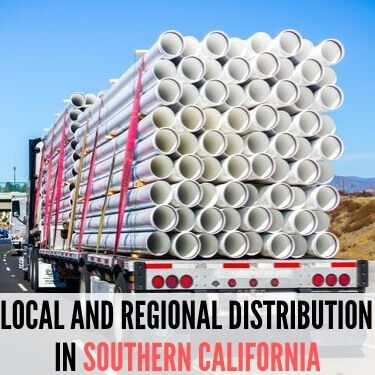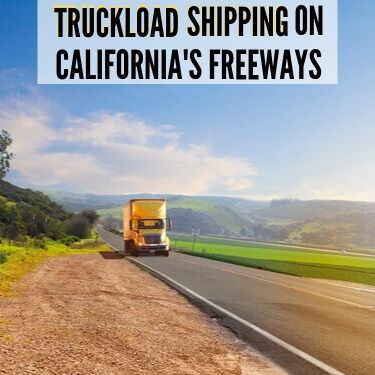For companies looking to break into new markets freight movement in Southern California can present a major hurdle to business development. Between rapid accelerating population growth, congested markets, infamously congested roadways, and the Amazon effect contributing to new consumer expectations, SoCal represents a unique set of challenges. When facing these on top of the ever-present logistics challenges of overland shipping, it is essential to enter this growing market with a strong plan in order to thrive.
To implement effective freight movement in Southern California, it is important to understand the different variables that make this region so challenging to new business. From understanding the scale of regional distribution major freight corridors to new initiatives for sustainability, this article’s introduction to goods movement planning in Southern California will help you on your first steps toward success.
For those unfamiliar with the Southern California region, it can present a uniquely challenging landscape to understand. The six-county SCAG region represents a huge amount of United States manufacturing jobs ranking fourth overall behind entire states like California, Texas, and Ohio. Major metropolises are included in the region such as Los Angeles, Long Beach, San Bernardino, San Diego, and Irvine. It’s a region known for innovation, entrepreneurship, and rapid development. As of the 2010 census, the SoCal region had a population of more than 22 million people.
All of those people require a large number of jobs and goods. Huge amounts of tonnage pass through Southern California, accounting for 60% of all freight shipped in the region, or over 447 million tons of goods. Thanks to the proximity to ports, 37% of US import duties are received by SoCal ports and eventually finds their way across the US thanks to the major north-bound and east-bound shipping lanes in the region. It makes for an area marked by high volumes of manufacturing, shipping, and freight and a major artery of industrial shipments in the US. The goods movement system available to businesses in the area allows for products to be delivered to a high percentage of the US population, both locally and across the country.
Thanks to the unique aspects of the Southern California region, it has exploded as a hub for not only national distribution but also shipping within the region. As a national hub, more than seven thousand trucking firms and thirty-two thousand five hundred wholesale trade businesses call Southern California home. This huge volume of businesses ranks the area second for wholesale trade employment among U.S. Metropolitan areas. This critical mass of employment and business doesn’t just send the freight onward throughout the U.S. - over thirty percent of the tonnage moved through stays in the six-county region. This all contributes to congested roads, air quality challenges, and a logistical cat’s cradle for new business ventures to navigate.
Want to learn more about shipping in Southern California? Check out are article on freight shipping in Los Angeles.

Freight moving out of California will make its way quickly across the county thanks to the proximity to several major interstates. Freight moving north will make its way along I-5 towards Oregon and Washington or I-15 Northeast towards Montana. Eastbound goods can move along I-10 towards Texas and Louisiana or I-40 through Oklahoma and Arkansas. I-70 can be accessed from I-15, offering more routes for products to head Northeast across the Plains states.
Each of the major corridors from Southern California can see more than 8,500 trucks a day hauling supplies to all corners of the US. The central location of the six-county region makes it a key component for goods movement planning for any business trying to optimize its transportation system.
Outside of the interstate hub, California’s freeways offer other freight movements in Southern California options for intraregional and local shipping. While the congestion is infamous for good reason (Los Angeles ranks #1 for traffic congestion in the US), these major routes are frequently being expanded and updated to deal with increased traffic demands. It’s not just the huge numbers of trucks contributing to the hours-long backups - the 710 in East LA is estimated by the California Department of Transportation to see upwards of 224,000 vehicles in peak hours. Researching alternate routes or solutions such as overnight shipments may help to reduce costly delays for freight movement over SoCal freeways.

All of the traffic, congestion, and freight being moved along the SoCal transportation systems takes a toll on the environment and residents. Carbon emissions contribute to poor air quality, increased health issues, and environmental issues such as the infamous Los Angeles smog.
Out of all the US states, California is on the leading edge of sustainable initiatives to combat climate change. The California Cleaner Freight Coalition’s Vision for a Sustainable Freight System in California lays out not just why they must find more sustainable means of transporting goods, but also how to achieve this. Possible solutions include:
When it comes to environmental initiatives, meeting and exceeding the standards expected from new regulations is essential to staying effective in California freight transport. These initiatives are expected to continue advancing in the coming years and will affect both transport equipment such as tractor-trailers, as well as port and intermodal equipment.
Unlocking the most effective channels of freight movement in Southern California is no easy task - the region boasts a huge share of the US freight transport, warehousing, and wholesale market, contributing to record congestion and delays. But the high volume exists for a reason: those businesses who successfully navigate the challenges of the SoCal transportation systems gain access to major freight corridors within the populous areas of Los Angeles, Long Beach, and other major cities, as well as easy routes to major interstates heading North and East.
Freight movement in Southern California can be tricky to navigate, so let us help you with available freight routes in California. Let R+L Global Logistics be your strategic partner in getting it there on time and intact. We also can be your partner in other states. For example, shipping corn in Texas and other commodities are services we can help you with. With 99 percent on-time delivery and top-notch customer service, R+L Global Logistics is prepared to be your California truckload shipping partner.
R+L Global Logistics
315 NE 14th St., Ocala, FL 34470